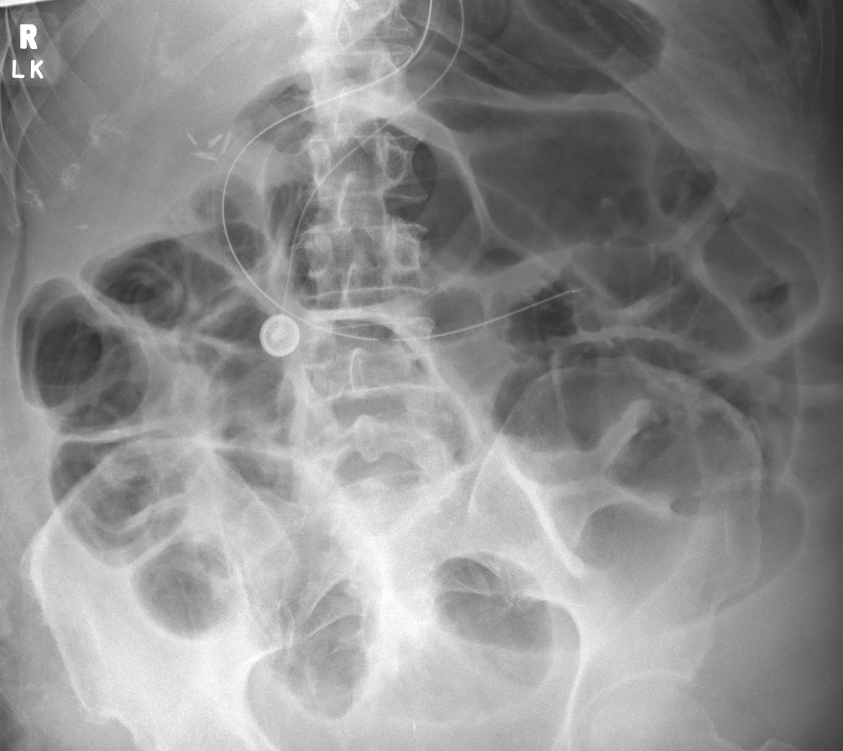Tuesday Poster Session
Category: Colon
P4713 - Myxedema Ileus: A Rarely Reported Colonic Manifestation of Myxedema Coma
Tuesday, October 28, 2025
10:30 AM - 4:00 PM PDT
Location: Exhibit Hall

Omar Zuhdi, MD
Lakeland Regional Health Medical Center
Lakeland, FL
Presenting Author(s)
Omar Zuhdi, MD1, Amanda Rigdon, MD1, Michael Sabina, DO2, Elizabeth Ziner, MD1
1Lakeland Regional Health Medical Center, Lakeland, FL; 2Lakeland Regional, Lakeland Regional, FL
Introduction: Myxedema coma is a severe form of hypothyroidism that is associated with altered mental status, hypothermia, bradycardia, hyponatremia, and hypoglycemia. Myxedema coma requires aggressive treatment due to its high mortality rate, ranging from 30 to 50% in some studies. Myxedema ileus is a rare complication of myxedema coma which can complicate management.
Case Description/
Methods: The patient is a 78-year-old male, with history of hypothyroidism, who presented to the emergency department as a trauma alert after being found unconscious during a police wellness check. The patient was found to be hypothermic at 33.8 °C, TSH was markedly elevated at 39.6 uIU/mL, free T4 less than 0.10 ng/dL, and free T3 low at 0.81 pg/mL. Patient continued to be encephalopathic and was intubated for airway protection and transferred to the ICU. Abdominal x-ray showed gas-filled dilated bowel loops throughout the abdomen, measuring up to 9.1 cm within the left lower quadrant suggestive of ileus. Due to lethargy, hypothermia, generalized edema, ileus, and bradycardia, patient was started on treatment for myxedema coma. The patient was started on levothyroxine, liothyronine, and hydrocortisone. Due to concern for ileus, the patient was started on a bowel regimen including docusate-senna, bisacodyl, and polyethylene glycol without resolution of his ileus. With continued treatment with levothyroxine and liothyronine, TSH improved to 21.9. A gastrografin enema was administered and showed diffuse distention of the colon. Following administration of gastrografin enema and continued treatment with levothyroxine and liothyronine, the patient had return of bowel function with multiple bowel movements.
Discussion: Hypothyroidism can cause decreased colonic activity; however, more severe forms of hypothyroidism such as myxedema coma can present with more significant colonic manifestations including myxedema ileus, pseudo-obstruction, volvulus, and megacolon. It is believed that myxedema coma causes myxedema ileus due to decreased sympathetic activity of the colon due to decreased circulating thyroid hormones as well as deposition of myxedematous material within the wall of the colon. In this case, myxedema ileus resolved with treatment of myxedema coma following administration of levothyroxine and liothyronine, as well as treatment with laxatives and gastrografin enema. Myxedema coma has a high patient mortality and early recognition of manifestations such as myxedema ileus is important to prevent further complications.

Figure: Distended bowel loops throughout the abdomen noted on x-ray, suggestive of ileus.
Disclosures:
Omar Zuhdi indicated no relevant financial relationships.
Amanda Rigdon indicated no relevant financial relationships.
Michael Sabina indicated no relevant financial relationships.
Elizabeth Ziner indicated no relevant financial relationships.
Omar Zuhdi, MD1, Amanda Rigdon, MD1, Michael Sabina, DO2, Elizabeth Ziner, MD1. P4713 - Myxedema Ileus: A Rarely Reported Colonic Manifestation of Myxedema Coma, ACG 2025 Annual Scientific Meeting Abstracts. Phoenix, AZ: American College of Gastroenterology.
1Lakeland Regional Health Medical Center, Lakeland, FL; 2Lakeland Regional, Lakeland Regional, FL
Introduction: Myxedema coma is a severe form of hypothyroidism that is associated with altered mental status, hypothermia, bradycardia, hyponatremia, and hypoglycemia. Myxedema coma requires aggressive treatment due to its high mortality rate, ranging from 30 to 50% in some studies. Myxedema ileus is a rare complication of myxedema coma which can complicate management.
Case Description/
Methods: The patient is a 78-year-old male, with history of hypothyroidism, who presented to the emergency department as a trauma alert after being found unconscious during a police wellness check. The patient was found to be hypothermic at 33.8 °C, TSH was markedly elevated at 39.6 uIU/mL, free T4 less than 0.10 ng/dL, and free T3 low at 0.81 pg/mL. Patient continued to be encephalopathic and was intubated for airway protection and transferred to the ICU. Abdominal x-ray showed gas-filled dilated bowel loops throughout the abdomen, measuring up to 9.1 cm within the left lower quadrant suggestive of ileus. Due to lethargy, hypothermia, generalized edema, ileus, and bradycardia, patient was started on treatment for myxedema coma. The patient was started on levothyroxine, liothyronine, and hydrocortisone. Due to concern for ileus, the patient was started on a bowel regimen including docusate-senna, bisacodyl, and polyethylene glycol without resolution of his ileus. With continued treatment with levothyroxine and liothyronine, TSH improved to 21.9. A gastrografin enema was administered and showed diffuse distention of the colon. Following administration of gastrografin enema and continued treatment with levothyroxine and liothyronine, the patient had return of bowel function with multiple bowel movements.
Discussion: Hypothyroidism can cause decreased colonic activity; however, more severe forms of hypothyroidism such as myxedema coma can present with more significant colonic manifestations including myxedema ileus, pseudo-obstruction, volvulus, and megacolon. It is believed that myxedema coma causes myxedema ileus due to decreased sympathetic activity of the colon due to decreased circulating thyroid hormones as well as deposition of myxedematous material within the wall of the colon. In this case, myxedema ileus resolved with treatment of myxedema coma following administration of levothyroxine and liothyronine, as well as treatment with laxatives and gastrografin enema. Myxedema coma has a high patient mortality and early recognition of manifestations such as myxedema ileus is important to prevent further complications.

Figure: Distended bowel loops throughout the abdomen noted on x-ray, suggestive of ileus.
Disclosures:
Omar Zuhdi indicated no relevant financial relationships.
Amanda Rigdon indicated no relevant financial relationships.
Michael Sabina indicated no relevant financial relationships.
Elizabeth Ziner indicated no relevant financial relationships.
Omar Zuhdi, MD1, Amanda Rigdon, MD1, Michael Sabina, DO2, Elizabeth Ziner, MD1. P4713 - Myxedema Ileus: A Rarely Reported Colonic Manifestation of Myxedema Coma, ACG 2025 Annual Scientific Meeting Abstracts. Phoenix, AZ: American College of Gastroenterology.
